Planning a trip to the vibrant Vietnamese capital and wondering Hanoi What To Eat? You’re in for a treat! Hanoi is a global hotspot for incredible street food, offering a culinary journey that delights the senses and tells stories of history and culture through each bite. From steaming bowls of noodle soup enjoyed on low plastic stools to crispy fried delights, the food scene here is an unmissable part of the travel experience. This guide shares some must-try dishes and where I savored them during my recent visit, proving that sometimes, the best travel plan is simply to eat your way through a city.
Hanoi’s street food culture is deeply ingrained in daily life. You’ll find everything from simple roadside carts with meager seating to slightly more established eateries with indoor spaces. The experience often involves grabbing any available low table and stool, ordering amidst the bustling activity, and getting ready for a flavor explosion.
Navigating menus can be an adventure, especially if you don’t speak Vietnamese. Pointing is a universal language! Point at the menu items or, when in doubt, point at what someone else is happily eating. It’s a fantastic way to step outside your comfort zone and discover something new.
Be prepared for the local approach – sometimes, the vendor might just serve you their specialty with all the fixings. Embrace it! It’s part of the fun and often leads to delightful surprises. Always have small Vietnamese Dong notes handy, as cash is king at most street food stalls. Breaking larger notes at a nearby shop before you eat is a smart move.
Here are the dishes I recommend adding to your Hanoi What To Eat list, based on personal experience and local recommendations.
Phở Bò (Beef Rice Noodle Soup)
You absolutely cannot talk about Hanoi What To Eat without starting with Phở Bò. This iconic dish is more than just soup; it’s a warm, comforting hug in a bowl, embodying the soul of Hanoian cuisine. Phở consists of a flavorful beef broth simmered for hours, soft flat rice noodles (phở), tender slices of beef (bò), and a scattering of fresh herbs and green onions. It’s a staple enjoyed any time of day, from a warming breakfast to a late-night supper.
The beauty of phở lies in its simplicity and the depth of flavor achieved through careful broth preparation. The rich aroma alone is enough to draw you in from down the street. Each bowl offers a balance of savory broth, delicate noodles, and fresh, vibrant herbs.
My first bowl of phở on this trip was at Phở Bò đường tàu, a spot near the famous Train Street. It was the perfect remedy after a flight – warming, restorative, and incredibly satisfying. The cost for a bowl was very affordable, a fraction of what you might pay elsewhere for comparable quality.
Later, on a motorbike tour, my guide introduced me to his favorite spot, Quán Phở Bò Đức Khôi. Here, the pho experience is often customized. Tables are typically adorned with condiments like lime wedges, fresh chilies, and sometimes chili sauce or vinegar, allowing you to adjust the broth’s flavor profile to your liking. This personal touch makes each bowl uniquely yours. You can also order ‘quẩy’ (fried dough fritters) to dip into the savory broth, adding a delightful textural contrast.
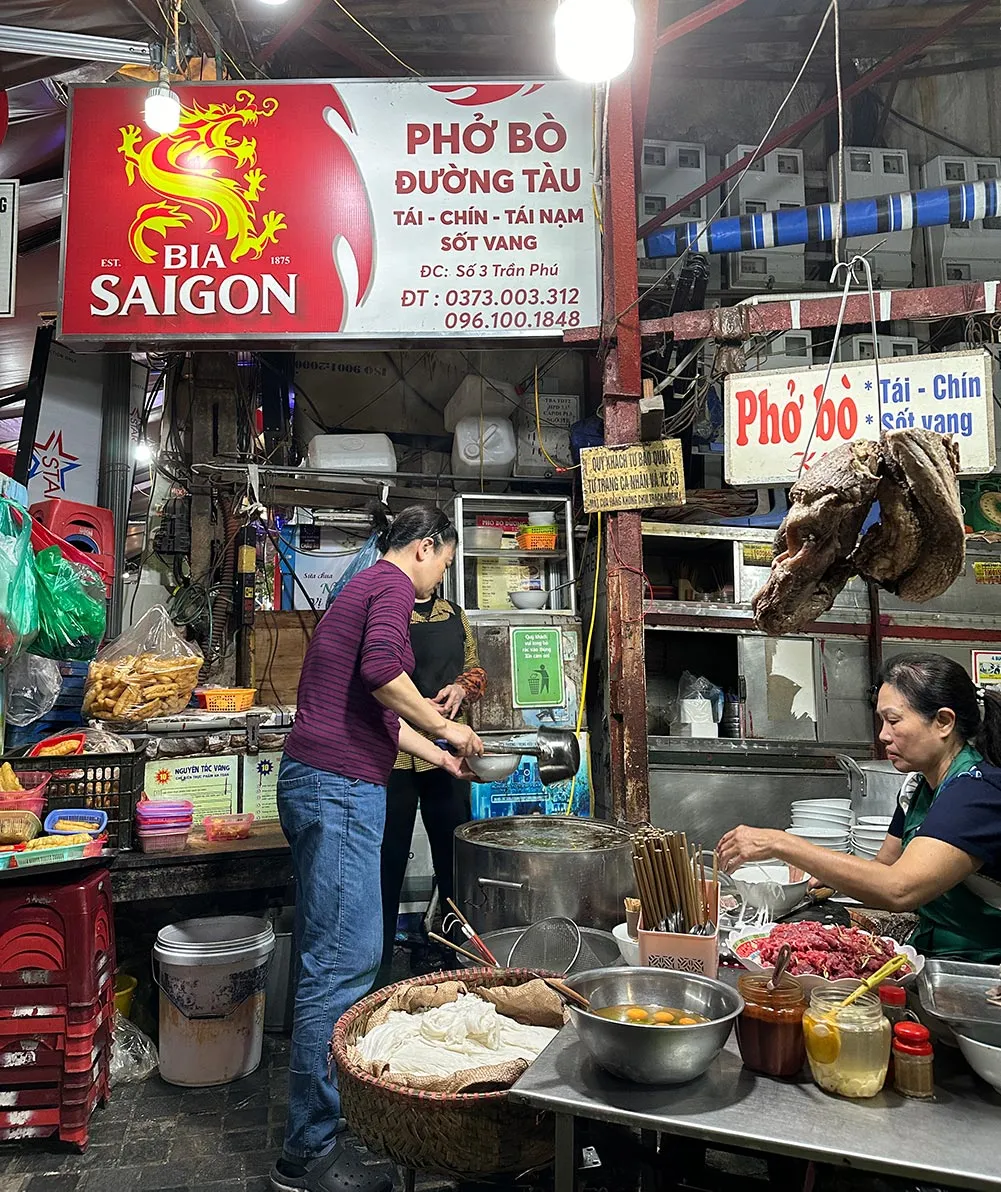 Hanoi Pho Bo Doung Tau WorkersA typical street food stall in Hanoi, bustling with activity.
Hanoi Pho Bo Doung Tau WorkersA typical street food stall in Hanoi, bustling with activity.
Where to Eat Phở Bò:
- Phở đường tàu (Train Street Pho): 3 P. Trần Phú, Hàng Bông, Hoàn Kiếm. (Google Maps: https://www.google.com/maps/place/Pho+Bo+Duong+Tau/@21.0300219,105.8438938,18.69z/data=!4m6!3m5!1s0x3135ab773ff30211:0x3fca36c31242f82e!8m2!3d21.0299458!4d105.8443364!16s%2Fg%2F11tf0r9n1v?entry=ttu)
- Quán Phở Bò Đức Khôi: 77 P. Phùng Hưng, Hàng Mã, Hoàn Kiếm. (Google Maps: https://www.google.com/maps/place/Qu%C3%A1n+Ph%E1%BB%9F+B%C3%B2+%C4%90%E1%BB%A9c+Kh%C3%B4i/@21.0364065,105.8436441,17z/data=!3m1!4b1!4m6!3m5!1s0x3135abbc05ba7313:0x48f1fe43987ae59!8m2!3d21.0364015!4d105.846219!16s%2Fg%2F1jkwhsyt6?entry=ttu)
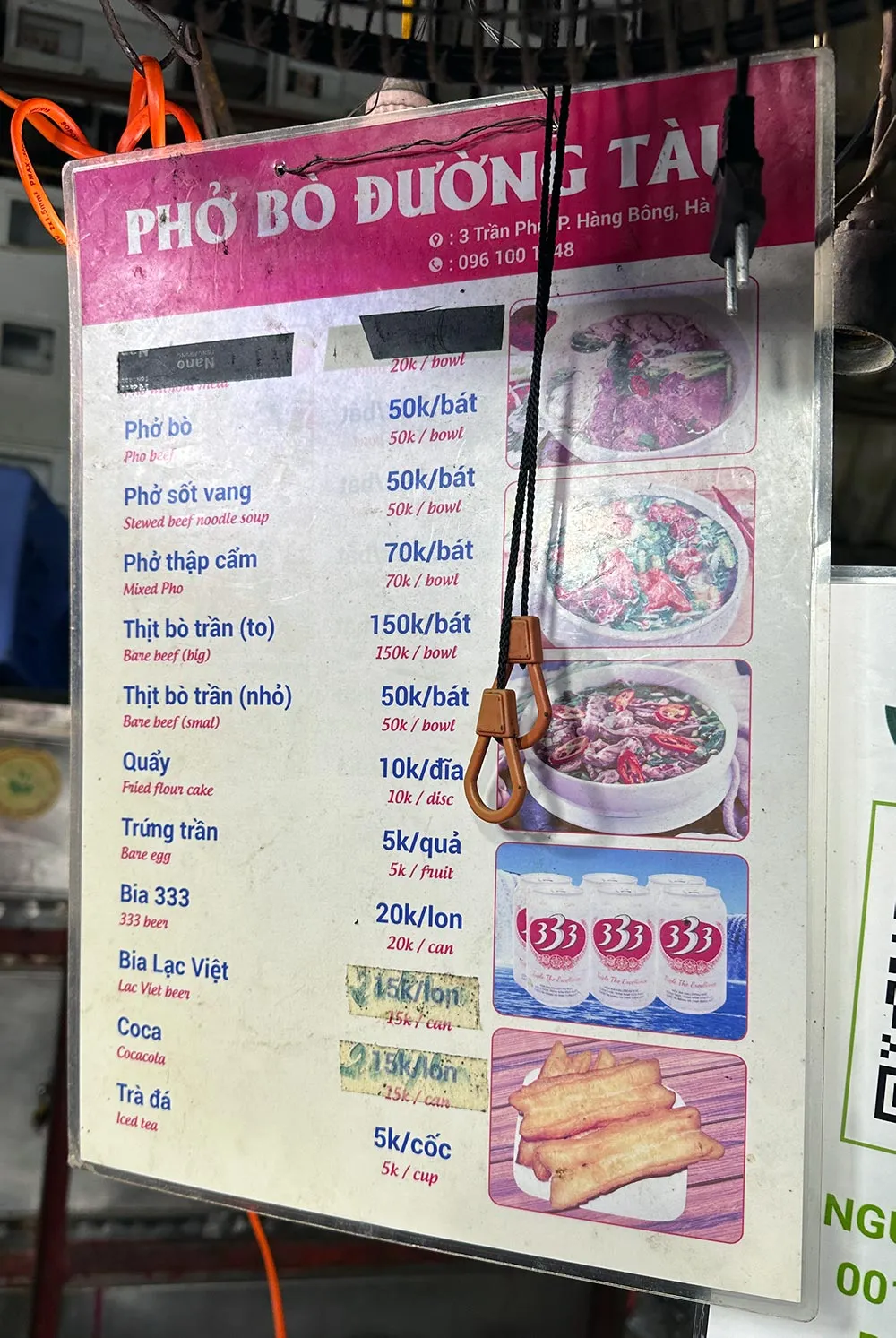 Hanoi Pho Bo Doung Tau MenuMenu showing different types of beef options available with your Pho.
Hanoi Pho Bo Doung Tau MenuMenu showing different types of beef options available with your Pho.
Bún Chả (Rice Vermicelli with Grilled Pork)
Another non-negotiable item on your Hanoi What To Eat list is Bún Chả. This dish offers a fascinating contrast to phở. Instead of hot soup poured over noodles, bún chả features dry, thick rice vermicelli noodles (bún) served separately from a warm, slightly sweet, fish-sauce based broth. This broth is filled with pieces of charcoal-grilled fatty pork slices (chả miếng) and seasoned minced pork patties (chả băm).
Served alongside is a generous mound of fresh herbs and vegetables – a true bounty of lettuce, perilla leaves, cilantro, and often sliced cucumber or green papaya. The ritual of eating bún chả involves dipping small bundles of noodles and herbs into the savory, warm broth with the grilled pork. Each mouthful is a delightful combination of textures and flavors – the soft noodles, the smoky, tender pork, the fresh, crisp greens, and the balanced sweet and savory dipping sauce.
What to Eat in Fort Worth – A Culinary Deep Dive
Discover the Top Restaurants in Denver – A Culinary Journey
Discover Where to Visit in Las Vegas
Bún chả gained international fame when it was shared by Anthony Bourdain and Barack Obama. While their specific restaurant, Bún chả Hương Liên, is popular, many excellent bún chả spots exist throughout the city. I visited Bún chả Đắc Kim, a well-regarded establishment.
Bún chả Đắc Kim, recognized by Michelin, offered a rich and flavorful broth. I particularly enjoyed the minced pork patties, which were incredibly tender. Beyond the standard bún chả, I also highly recommend ordering a side of ‘nem cua bể’ – a crispy, fried crab spring roll often served with bún chả. Dipped in the same delicious broth, it adds another layer of texture and taste. Sharing a table with another solo traveler here even led to a pleasant afternoon spent exploring together – highlighting the social aspect of street food!
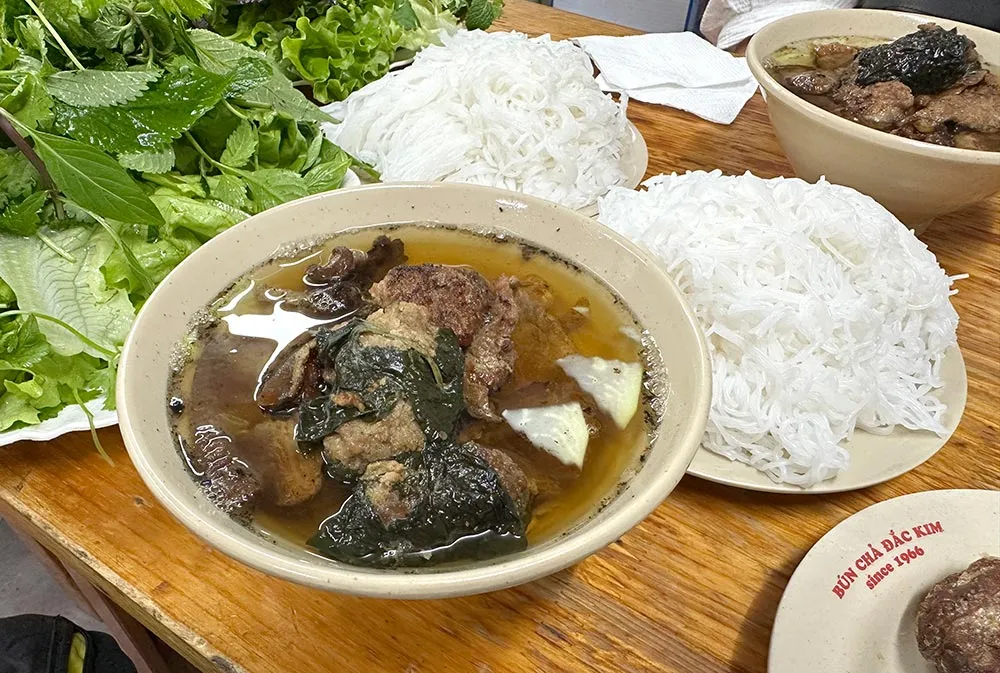 Hanoi Bun Cha Dac Kim MealA delicious serving of Bun Cha with plenty of noodles and fresh herbs.
Hanoi Bun Cha Dac Kim MealA delicious serving of Bun Cha with plenty of noodles and fresh herbs.
Where to Eat Bún Chả:
- Bún chả Đắc Kim: 1 P. Hàng Mành, Hàng Gai, Hoàn Kiếm. (Google Maps: https://www.google.com/maps/place/Bun+Cha+Dac+Kim/@21.0322882,105.8479731,21z/data=!4m6!3m5!1s0x3135abbe40899a17:0x9aa20a2ad5a0f0e4!8m2!3d21.0322493!4d105.8482095!16s%2Fg%2F1thpz5ms?entry=ttu)
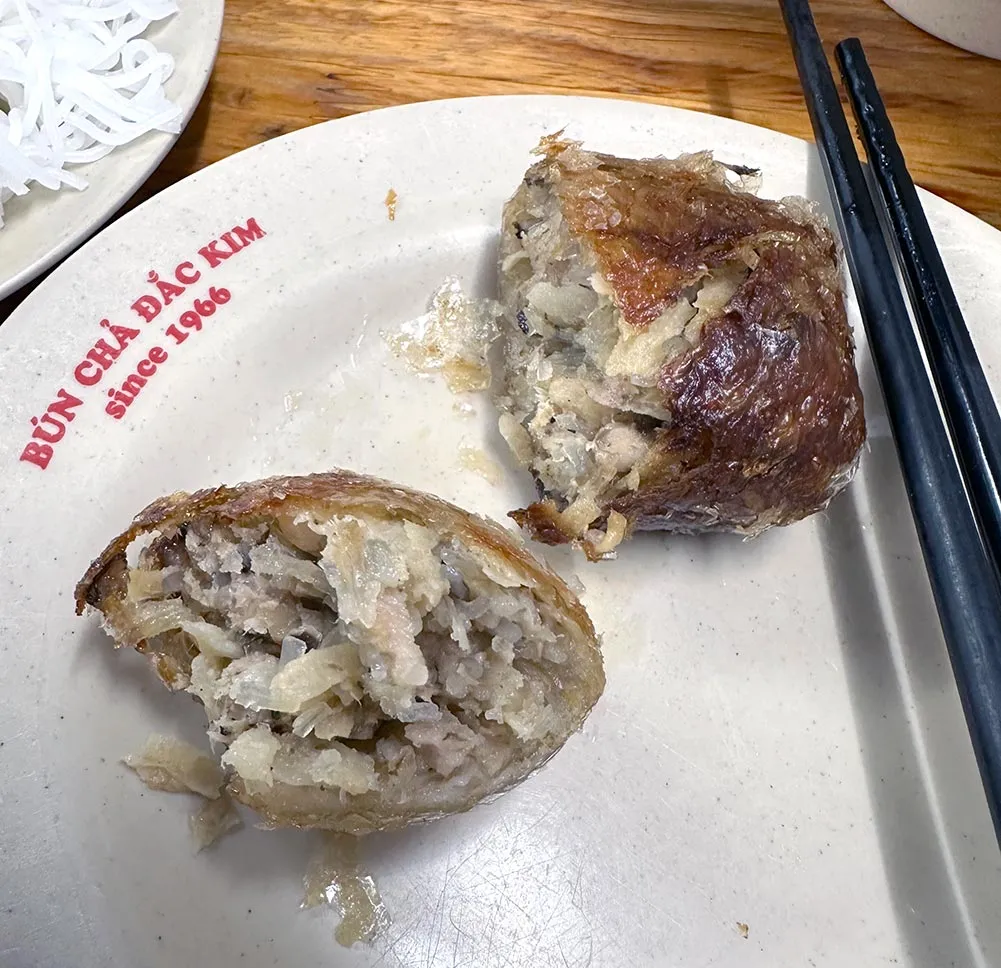 Hanoi Bun Cha Dac Kim Crab RollThe crispy and flavorful Nem Cua Be (fried crab spring roll) often ordered as a side.
Hanoi Bun Cha Dac Kim Crab RollThe crispy and flavorful Nem Cua Be (fried crab spring roll) often ordered as a side.
Bún Riêu (Rice Vermicelli Crab-Tomato Soup)
For something different yet equally delicious when deciding Hanoi What To Eat, try Bún Riêu. This vibrant soup features a rich, tangy broth made with tomatoes and freshwater crab paste. It’s a dish with a distinct flavor profile, often incorporating ingredients like fried tofu, pork, and sometimes snails (ốc). The broth gets its characteristic color and flavor from tomatoes and annatto seed oil.
Served with thick white rice vermicelli noodles (bún), bún riêu is typically garnished with herbs, shredded morning glory, and banana blossoms. The crab paste used isn’t usually large chunks of crab meat, but rather a paste made from pounded crab, which gives the soup its unique texture and umami depth.
I discovered Bún Riêu thanks to some friendly Hanoian locals. They pointed me towards a small roadside stall, Bún Riêu Phố Cổ. Despite a slightly gruff vendor, the steaming bowl of tomato-based soup with tofu and noodles was a revelation. My bowl included some beef, showing the variations available – sometimes you get what you point at, which is all part of the adventure!
An optional but traditional condiment for Bún Riêu (and also central to the dish Bún Đậu) is Mắm Tôm, a pungent fermented shrimp paste. A tiny spoonful can add a powerful punch of flavor for the adventurous eater, but be warned – its smell is very strong! Experiencing Bún Riêu offers a taste of the diverse noodle soup landscape in Hanoi, moving beyond the familiar phở.
 Hanoi Bun Rieu Pho Co NoodlesA steaming bowl of Bun Rieu with rice vermicelli, tofu, and tomato broth.
Hanoi Bun Rieu Pho Co NoodlesA steaming bowl of Bun Rieu with rice vermicelli, tofu, and tomato broth.
Where to Eat Bún Riêu:
- Bún Riêu Phố Cổ: 17 Hàng Cót, Hàng Mã, Hoàn Kiếm. (Google Maps: https://www.google.com/maps/place/B%C3%BAn+Ri%C3%AAu+Ph%E1%BB%91+C%E1%BB%95/@21.0381696,105.8471386,16z/data=!4m6!3m5!1s0x3135abb964ed0b15:0x9905c0d1e351826c!8m2!3d21.0383862!4d105.8472016!16s%2Fg%2F11q2ykfpss?entry=ttu)
- Bún riêu cua Hàng Bạc: Closer to Hoan Kiem Lake, another popular option. (Google Maps: https://www.google.com/maps/place/B%C3%BAn+ri%C3%AAu+cua+H%C3%A0ng+B%E1%BA%A1c/@21.0340275,105.8448585,16.54z/data=!4m6!3m5!1s0x3135abc08d02936d:0x552fd8ab4a3f93f1!8m2!3d21.0337309!4d105.8534948!16s%2Fg%2F11b7q86blv?entry=ttu)
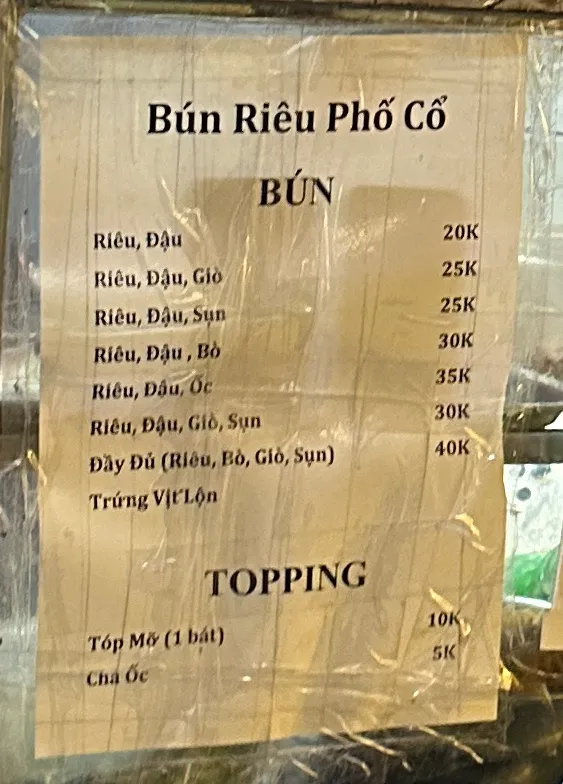 Hanoi Bun Rieu Pho Co MenuA close-up view of the menu at a Bun Rieu stall, showing various options.
Hanoi Bun Rieu Pho Co MenuA close-up view of the menu at a Bun Rieu stall, showing various options.
Chả Cá Lăng (Fried Turmeric Fish with Dill)
Moving slightly up from street food stalls to more dedicated restaurants, Chả Cá Lăng (also known as Chả Cá Lã Vọng after the street where it originated) is a uniquely Hanoian specialty worth seeking out for your Hanoi What To Eat list. This dish features chunks of Hemibagrus fish (cá lăng) marinated in turmeric and galangal, then pan-fried with copious amounts of dill and green onions.
The magic of Chả Cá happens right at your table. A hot pan is brought out, filled with the marinated fish and oil. You then add the herbs and cook it yourself, creating a fragrant, sizzling spectacle. It’s typically served with rice vermicelli noodles (bún), roasted peanuts, fresh dill, cilantro, and a shrimp paste dipping sauce (mắm tôm) or a lighter fish sauce (nước chấm).
The experience of cooking and assembling each bite yourself makes Chả Cá interactive and memorable. You combine the cooked fish and herbs with noodles and condiments in your bowl, creating a fresh, flavorful mix. While the abundance of dill might be overwhelming for some, its unique aroma is central to the dish’s character.
I tried Chả Cá at Chả Cá Thăng Long, a popular restaurant specializing in this dish. The staff were helpful, even explaining the cooking and eating process in English. The set meal also included a ‘Nem cá Lăng’, a tasty fried spring roll made with the same fish. It’s a bit pricier than typical street food, reflecting the restaurant setting and specialized nature of the dish, but definitely a worthwhile culinary adventure in Hanoi.
 Hanoi Cha Ca Thang Long Fish PanHemibagrus fish cooked with dill and green onions in a pan at the table.
Hanoi Cha Ca Thang Long Fish PanHemibagrus fish cooked with dill and green onions in a pan at the table.
Where to Eat Chả Cá Lăng:
- Chả Cá Thăng Long: 6B P. Đường Thành, Cửa Đông, Hoàn Kiếm. (Google Maps: https://www.google.com/maps/place/Cha+Ca+Thang+Long/@21.0323583,105.8460748,18.22z/data=!4m6!3m5!1s0x3135ab101293ee4d:0x2cc23b2f11a4fc51!8m2!3d21.032942!4d105.8461296!16s%2Fg%2F11vd9wv92l?entry=ttu)
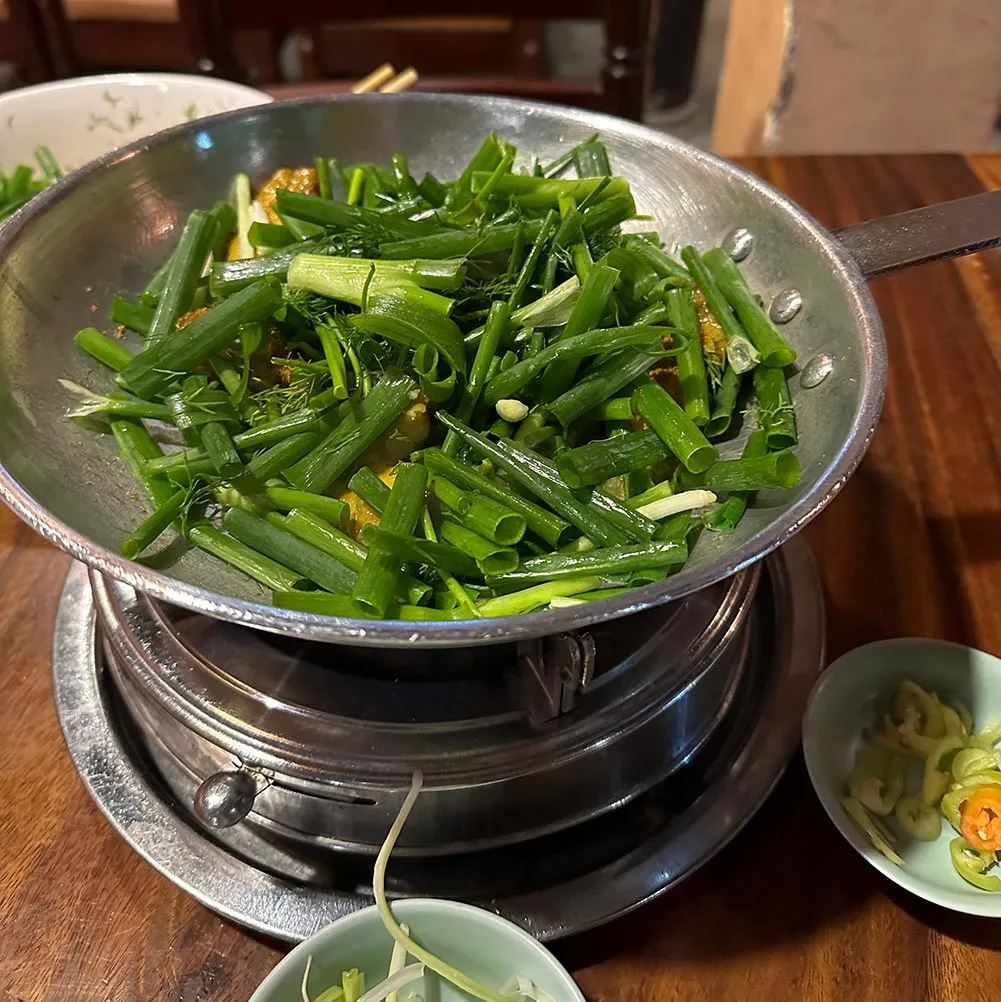 Hanoi Cha Ca Thang Long Fried Fish DillA generous portion of dill and green onions ready to be added to the pan.
Hanoi Cha Ca Thang Long Fried Fish DillA generous portion of dill and green onions ready to be added to the pan.
Bánh Mì Sốt Vang (Beef Stew with Baguette)
Exploring Hanoi What To Eat also means discovering culinary influences from its past. Bánh Mì Sốt Vang is a delicious example, showcasing French colonial impact on Vietnamese cuisine. Sốt Vang is a rich, savory beef stew made with tomatoes, carrots, and spices, often incorporating a touch of red wine (vạng means wine in Vietnamese). It’s a hearty, comforting dish perfect for dipping with a crispy Vietnamese baguette (bánh mì).
The bánh mì served with Sốt Vang is typically warm and freshly baked, with a thin, crackly crust and a soft, airy interior. It’s the ideal vessel for soaking up the flavorful, thick stew. The combination of the tender beef, aromatic sauce, and fresh bread is simply wonderful.
I tried this dish at Bánh mì Trâm near Van Mieu (Temple of Literature). The stew was flavorful and warming, but the star was truly the baguette – perfectly crispy outside, soft inside. It was a delight to tear off pieces and scoop up the rich Sốt Vang. The service here was notably friendly, adding to the positive experience.
While you can find variations like phở bò sốt vang (pho noodles in beef stew broth) elsewhere, the classic pairing with a freshly baked bánh mì at places like Bánh mì Trâm is highly recommended. This dish is a testament to how Vietnamese cuisine creatively adopted and adapted foreign elements into its own unique and beloved dishes.
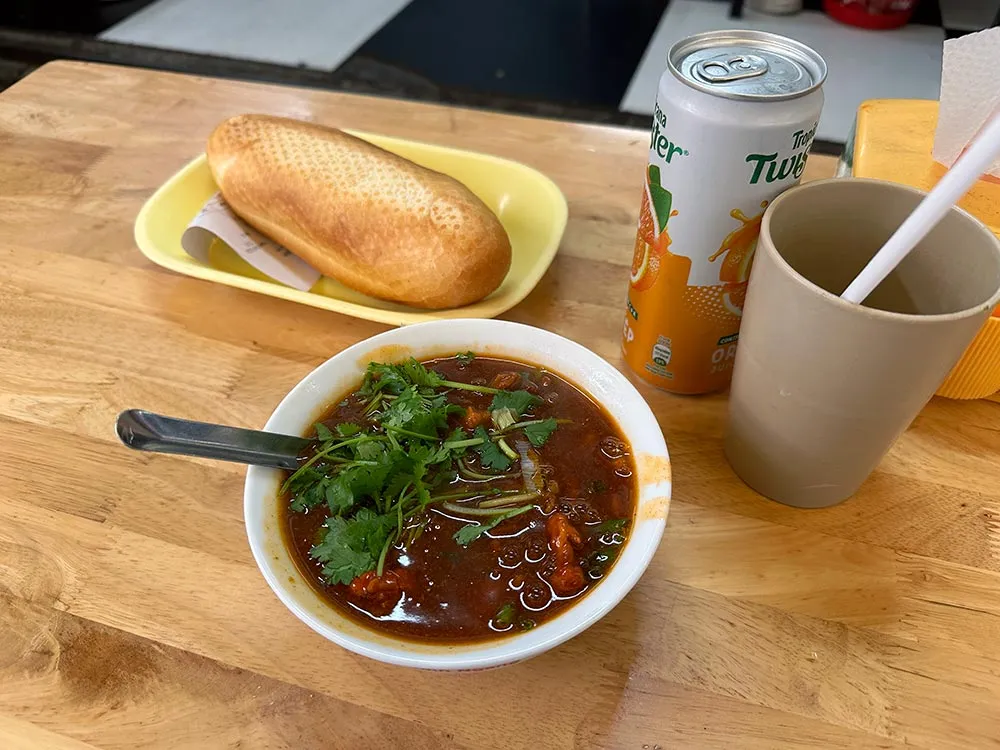 Hanoi Banh Mi Tram Sot VangA bowl of rich Beef Stew (Sot Vang) served with a crispy Vietnamese baguette (Banh Mi).
Hanoi Banh Mi Tram Sot VangA bowl of rich Beef Stew (Sot Vang) served with a crispy Vietnamese baguette (Banh Mi).
Where to Eat Bánh Mì Sốt Vang:
- Bánh mì Trâm: 30 P. Đình Ngang, Cửa Nam, Hoàn Kiếm. (Google Maps: https://www.google.com/maps/place/B%C3%A1nh+m%C3%AC+Tr%C3%A2m/@21.0281349,105.8400108,17z/data=!3m1!4b1!4m6!3m5!1s0x3135abe41a3d1b51:0x484eae8aa905b2a!8m2!3d21.0281299!4d105.8425857!16s%2Fg%2F11qbfgtyp1?entry=ttu)
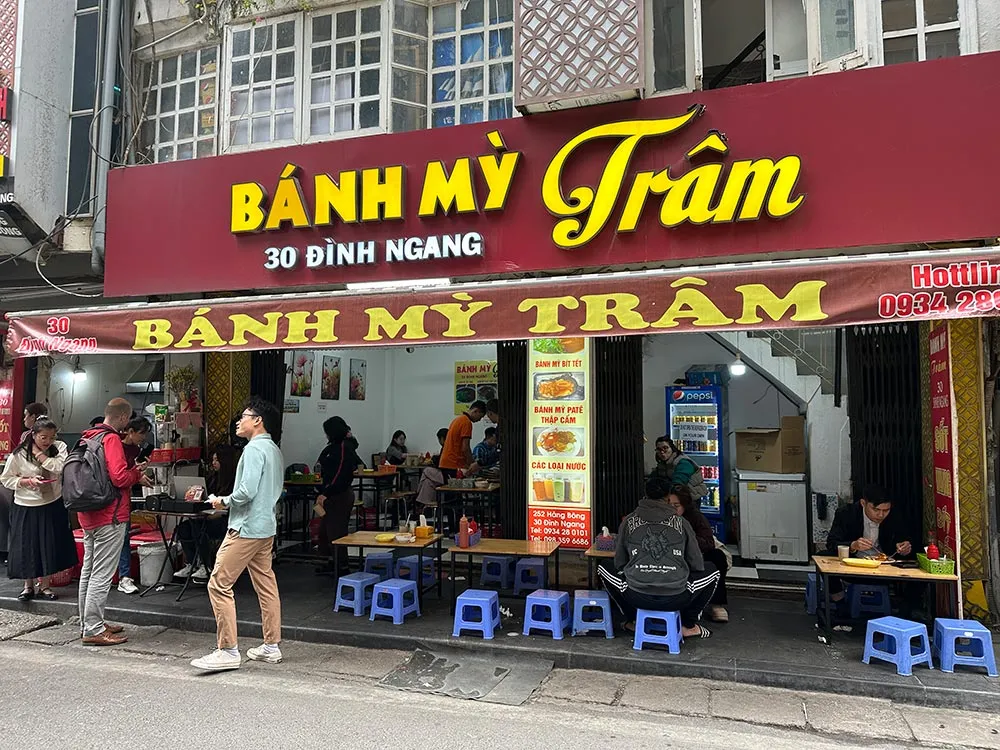 Hanoi Banh Mi Tram ShopThe exterior of Banh Mi Tram shop, offering both indoor and outdoor seating.
Hanoi Banh Mi Tram ShopThe exterior of Banh Mi Tram shop, offering both indoor and outdoor seating.
Cháo Sườn (Pork Rib Congee/Porridge)
When seeking comfort food on your Hanoi What To Eat journey, look no further than Cháo Sườn. This isn’t your typical watery rice porridge; it’s a thick, smooth, almost paste-like congee, often compared to Cantonese-style jook. Made by cooking rice down until it breaks apart and dissolves into the broth, it’s usually flavored with pork bones and small pieces of pork ribs.
What elevates Cháo Sườn are the toppings. My bowl from Cháo sườn cô Là was generously piled high with crispy fried dough fritters (giò cháo quẩy) and what looked like fried pork floss. These additions provide texture and savory richness that perfectly complement the creamy porridge base.
Eating Cháo Sườn, especially on a cool Hanoi morning, often involves finding a low stool on the sidewalk – sometimes even stacking chairs to create a makeshift table. It’s a quintessential street food experience, simple yet incredibly satisfying. The warmth and comforting texture make it a perfect start to the day or a gentle supper.
It’s a simple dish, but the execution of the porridge consistency and the quality of the toppings make all the difference. The version I had was truly “the whole works,” showcasing how basic ingredients can be transformed into something deeply comforting and delicious.
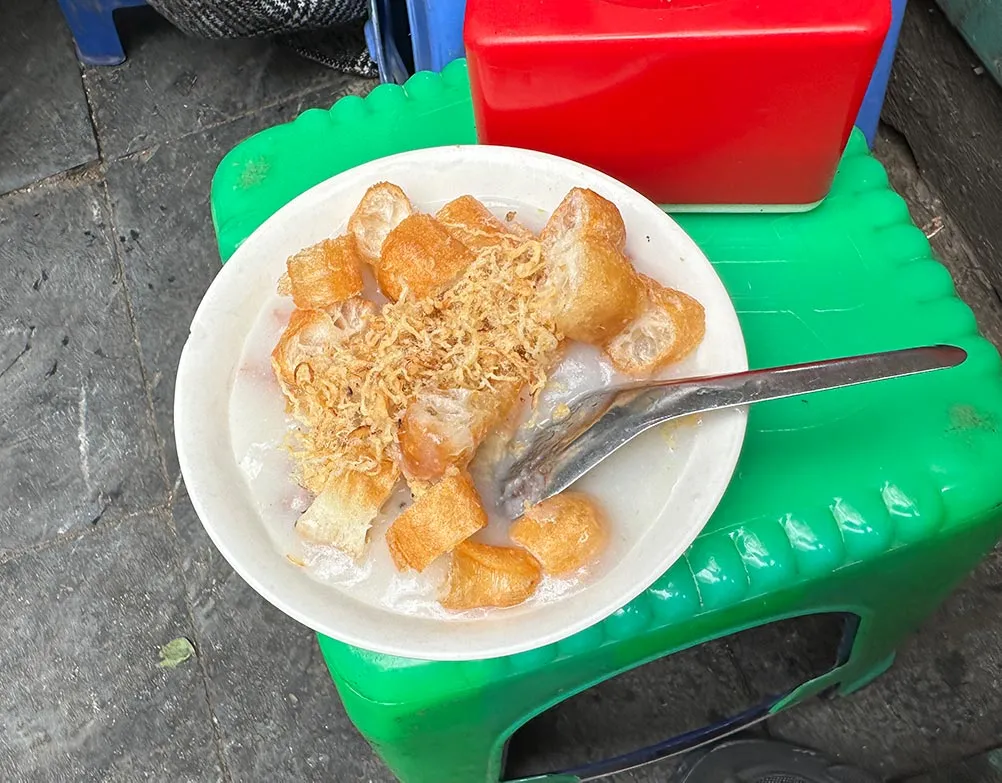 Hanoi Chao Suon Co La PorridgeA hearty bowl of Cháo Sườn topped with fried dough fritters and pork floss.
Hanoi Chao Suon Co La PorridgeA hearty bowl of Cháo Sườn topped with fried dough fritters and pork floss.
Where to Eat Cháo Sườn:
- Cháo sườn cô Là: 2A P. Lý Quốc Sư, Hàng Trống, Hoàn Kiếm. (Google Maps: https://www.google.com/maps/place/Ch%C3%A1o+s%C6%B0%E1%BB%9Dn+c%C3%B4+L%C3%A0/@21.0307963,105.8459017,17z/data=!3m1!4b1!4m6!3m5!1s0x3135abdf9c4caa2f:0xbebb3230249bd048!8m2!3d21.0307913!4d105.8484766!16s%2Fg%2F11h3k72sw2?entry=ttu)
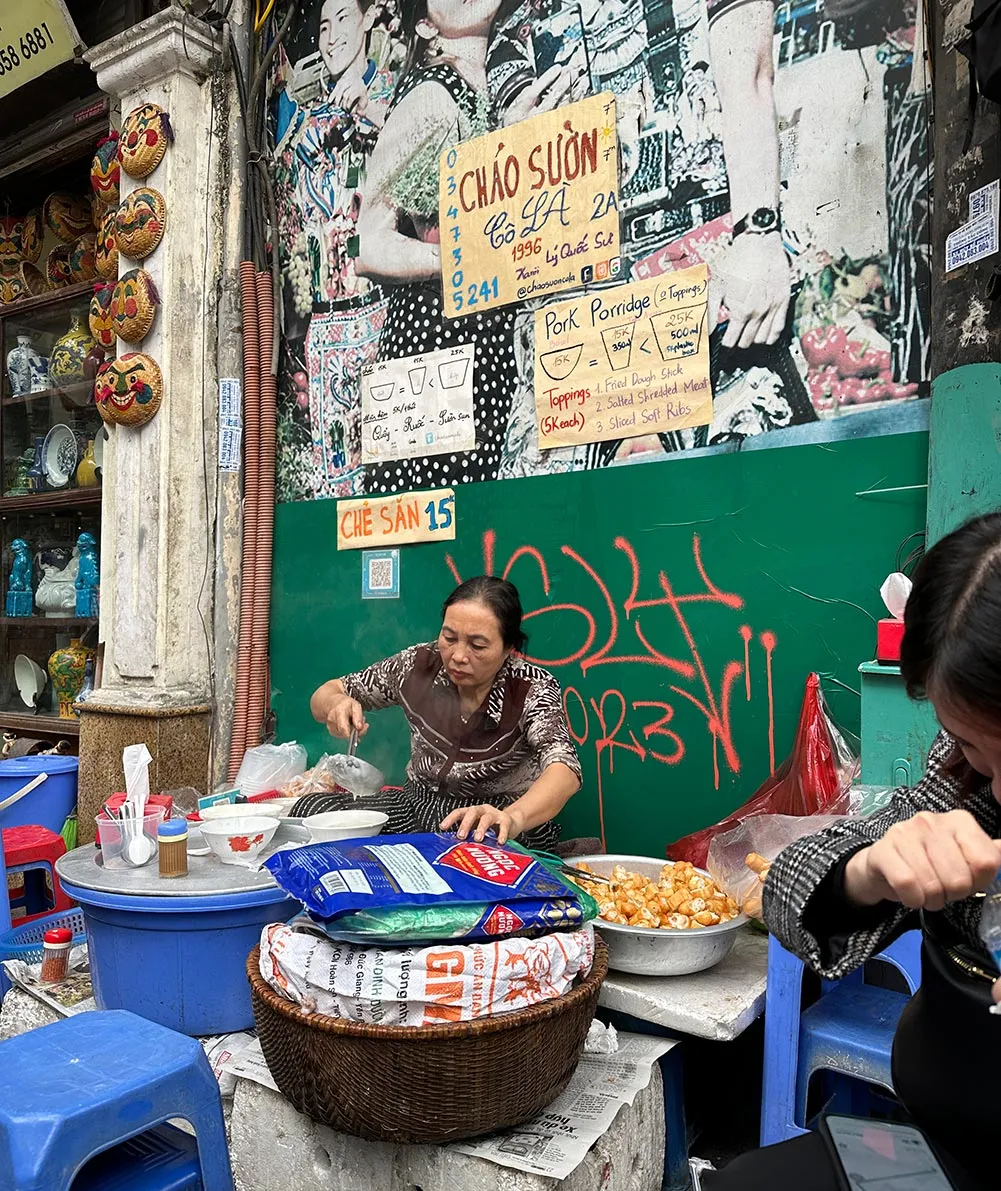 Hanoi Chao Suon Co La StallA humble roadside stall selling delicious Cháo Sườn in Hanoi.
Hanoi Chao Suon Co La StallA humble roadside stall selling delicious Cháo Sườn in Hanoi.
Nem Nướng (Grilled Pork Sausage)
While fresh spring rolls (gỏi cuốn) are famous, Hanoi also offers unique variations like those featuring Nem Nướng, a savory grilled pork sausage often associated with Nha Trang in Southern Vietnam, adapted into a DIY spring roll experience here. Deciding Hanoi What To Eat should definitely include trying local interpretations of classic dishes.
This dish is all about personalization. You’re presented with a platter of ingredients: thin rice paper wrappers, soft rice vermicelli noodles (phở), fresh greens like lettuce and herbs, pickled green mango and cucumber, fried mung bean paper, and of course, slices of the fragrant, grilled Nem Nướng sausage.
The fun part is assembling your own rolls. You take a rice paper wrapper, add your desired mix of noodles, vegetables, and the grilled pork, then roll it up. The crucial element that brings it all together is the dipping sauce (nước chấm). At Nem Nướng Nha Trang Quế Hoa, where I tried this, the sauce was served warm and had a delicious balance of savory, slightly sweet, and tangy flavors – truly exceptional and key to the dish’s success.
Each bite offers a fresh, crispy, chewy, and savory sensation. It’s a light yet satisfying option, perfect for a snack or a lighter meal, and the interactive nature of rolling your own makes it a memorable dining experience. It highlights how Vietnamese cuisine plays with textures and flavors.
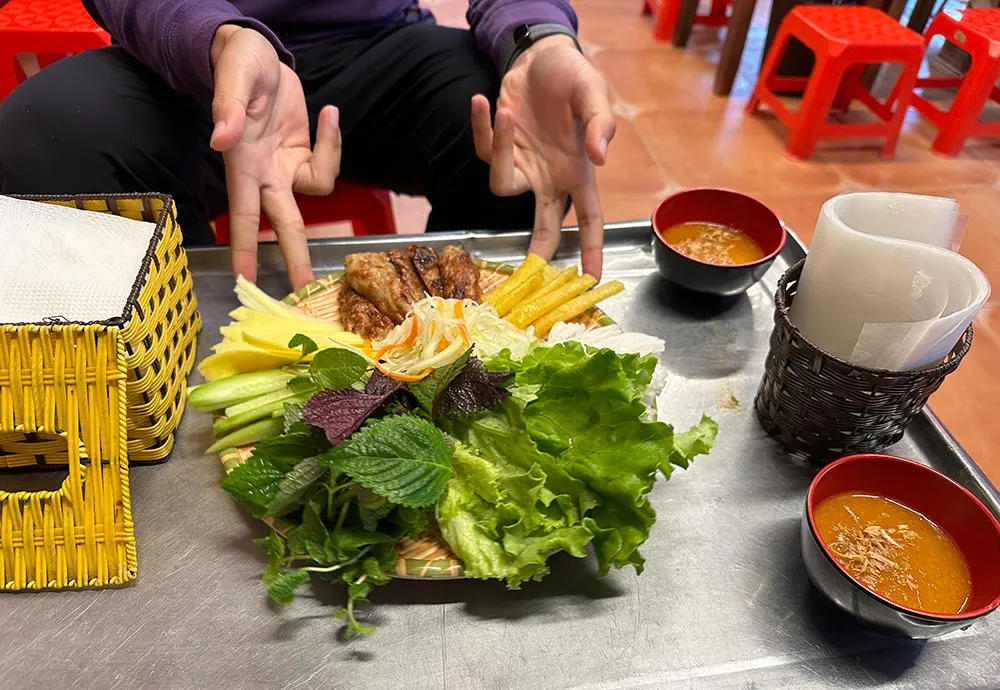 Hanoi Nem Nuong Nha Trang Que Hoa IngredientsVarious fresh ingredients for making Nem Nướng spring rolls.
Hanoi Nem Nuong Nha Trang Que Hoa IngredientsVarious fresh ingredients for making Nem Nướng spring rolls.
Where to Eat Nem Nướng:
- Nem Nướng Nha Trang Quế Hoa: 23 P. Hồ Hoàn Kiếm, Hàng Bạc, Hoàn Kiếm. (Google Maps: https://www.google.com/maps/place/Nem+N%C6%B0%E1%BB%9Bng+Nha+Trang+Qu%E1%BA%BF+Hoa/@21.0317227,105.8530593,20.18z/data=!4m6!3m5!1s0x3135abdcf171a5ff:0xd5bba4b81ba96429!8m2!3d21.0319805!4d105.8532199!16s%2Fg%2F11rnk0dv49?entry=ttu)
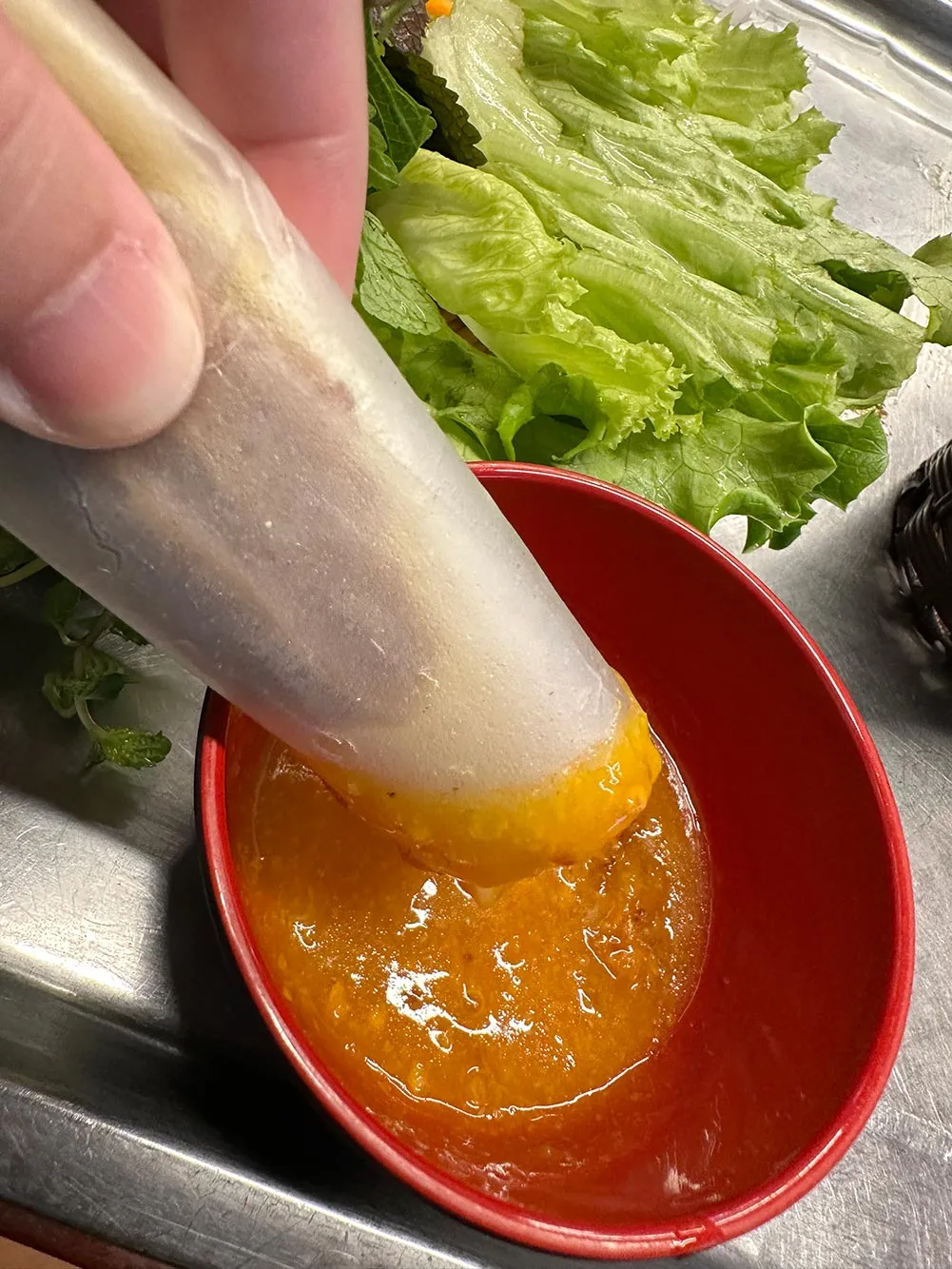 Hanoi Nem Nuong Nha Trang Que Hoa RollA freshly made Nem Nướng spring roll dipped in the warm, savory sauce.
Hanoi Nem Nuong Nha Trang Que Hoa RollA freshly made Nem Nướng spring roll dipped in the warm, savory sauce.
Other Highly Recommended Hanoi Foods (I Missed!)
Even with the best intentions and a hearty appetite, a short trip means you can’t possibly try everything on the incredible Hanoi What To Eat list. Here are a few other dishes that came highly recommended by locals and fellow travelers but which I sadly didn’t get to sample this time:
- Bún Đậu Mắm Tôm: Dry vermicelli noodles served with fried tofu, various pork parts, and herbs, typically eaten with a strong fermented shrimp paste (mắm tôm). For the adventurous!
- Cà Phê Trứng (Egg Coffee): A rich, creamy coffee drink made with egg yolk, sugar, and condensed milk. A must-try beverage experience in Hanoi.
- Bánh Cuốn: Steamed rice rolls filled with minced pork and mushrooms, often served with fried shallots and a dipping sauce.
- Nem Phùng: A fermented pork roll wrapped in fig leaves, a specialty from Phùng town near Hanoi.
Consider adding these to your list if your stomach capacity allows!
Enhance Your Culinary Journey: Hanoi Food Tours
One fantastic way to dive deep into the Hanoi What To Eat scene, especially if you’re short on time or new to street food, is to take a guided food tour. These tours not only lead you to hidden gems but also provide context about the dishes, ingredients, and the culture surrounding them.
Many tours involve navigating the bustling streets, often on the back of a motorbike, which is an experience in itself! It allows you to cover more ground and truly feel the pulse of the city. I took a sightseeing motorbike tour that included some food stops, which was a brilliant way to combine exploration and eating.
Look for tours specifically focused on street food in the Old Quarter, where many iconic dishes are found. Guides can help with ordering, explain the nuances of each dish, and share insights into local life you might otherwise miss. It’s an investment in your culinary education and overall travel experience.
 Hanoi Motorbike Tour Me GuideA traveler with their guide during a motorbike tour in Hanoi, exploring the city’s sights and tastes.
Hanoi Motorbike Tour Me GuideA traveler with their guide during a motorbike tour in Hanoi, exploring the city’s sights and tastes.
Conclusion: Your Hanoi What To Eat Adventure Awaits
Hanoi’s food scene is a captivating blend of flavors, textures, and history. Deciding Hanoi What To Eat is half the fun – the other half is the adventure of finding and savoring these dishes in their authentic settings. From the comforting warmth of phở to the tangy kick of bún riêu and the interactive delight of chả cá, each meal offers a glimpse into the city’s soul.
Whether you’re a seasoned food lover or new to Vietnamese cuisine, Hanoi provides an unforgettable culinary journey. Don’t be afraid to try new things, brave the low plastic stools, and let your taste buds lead the way. The vibrant street life and incredible food are waiting.
If you’ve been to Hanoi, what are your absolute must-try food recommendations? Share your favorite dishes and spots in the comments below to help fellow travelers plan their own delicious trips!
Frequently Asked Questions about Hanoi Food
- What is the most famous food in Hanoi?
The most famous food widely associated with Hanoi is Phở, particularly Phở Bò (beef pho) or Phở Gà (chicken pho). Bún Chả is also extremely famous, especially after gaining international media attention. - Is street food in Hanoi safe to eat?
Generally, yes, but it’s wise to be observant. Look for stalls that are busy with locals, have a high turnover of food (meaning ingredients are fresh), and appear reasonably clean. Eating where others are queuing is often a good sign. Your hotel or a food tour guide can also offer trusted recommendations. - What are the typical prices for street food in Hanoi?
Street food is very affordable. Noodle soups like Pho or Bun Cha typically range from 30,000 VND to 70,000 VND (roughly $1.20 – $3 USD). More complex dishes served in restaurants like Cha Ca will be higher, maybe 150,000 VND to 250,000 VND ($6 – $10 USD) per person. - Do I need cash for street food?
Yes, almost all street food stalls and smaller eateries in Hanoi operate on a cash-only basis. It’s essential to carry small denominations of Vietnamese Dong (VND). - Are there options for vegetarians in Hanoi?
While many traditional dishes feature meat or seafood, vegetarian options (chay) are increasingly available, especially in tourist areas. Look for “Cơm Chay” (vegetarian rice) or “Phở Chay” (vegetarian pho) at specific vegetarian restaurants or sometimes alongside regular menus. - What is Egg Coffee and where can I try it?
Egg Coffee (Cà Phê Trứng) is a unique Hanoian drink made with strong Vietnamese coffee topped with a creamy, whisked mixture of egg yolk and condensed milk. It tastes like a rich coffee custard. Famous spots include Cafe Giang and Cafe Dinh.
